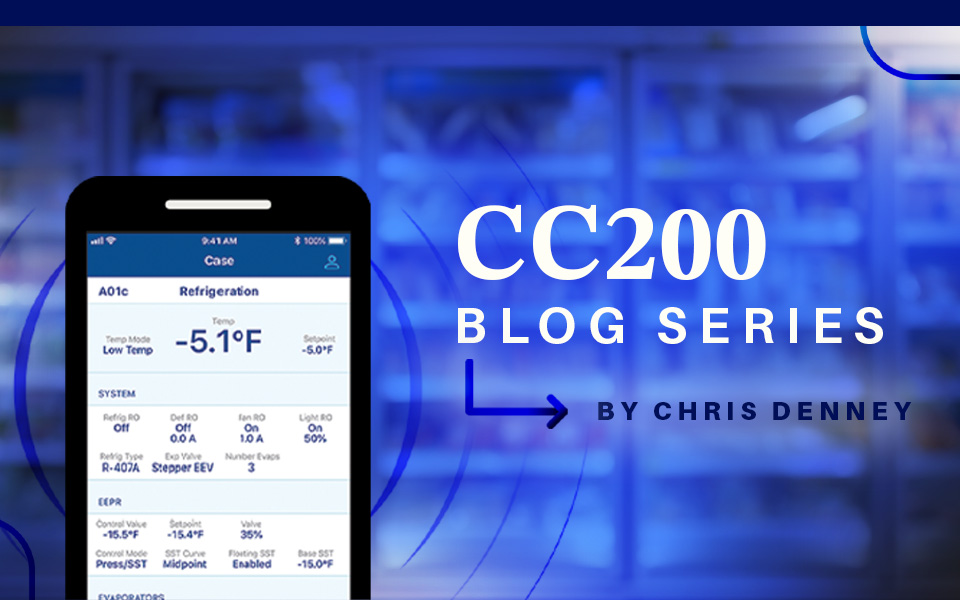*On June 1, 2023 Emerson’s Climate Technologies business became a new standalone company – Copeland. Though our name has changed, we are building on more than a century of HVACR innovation and industry leadership, and Copeland continues to offer the same products, industry stewardship, and learning opportunities you’ve grown to trust. Information found on this webpage posted before June 1, 2023 may contain our old name or branding, but you can be at ease knowing it was created with the knowledge and expertise of Copeland.
In the first blog of our Innovations in Case Control series, I reviewed the hardware components, technician-friendly features and performance benefits of Copeland’s new CC200 case controller. Designed with modular, pluggable components, it enables control of up to three evaporators or an electronic evaporator pressure regulator (EEPR) valve for multiple types of cases. In this blog, I explore how this robust case control platform regulates superheat, manages EEPR valves, and provides advanced CO2-ready functionality. To dive deeper into these topics, please view our companion CC200 video series.

Auto-tuning superheat regulation
Precise control over evaporator superheat and pressure is essential to maximizing energy efficiency and refrigerated case performance. The CC200 solution combines high-accuracy sensors and advanced control algorithms to monitor air temperatures and automatically fine-tune optimum superheat setpoints.
A typical CC200 installation consists of at least one pressure transducer and one coil outlet temperature sensor on the evaporator. The CC200 converts the pressure to a dewpoint saturated suction temperature (SST) and uses the coil outlet temperature sensor to determine the superheat value. Superheat is continually monitored and regulated by opening or closing an electronic expansion valve (EEV) to maintain the superheat setpoint.
In a circuit of refrigerated cases, multiple evaporators run at the same superheat setpoint and suction pressure. Often, air temperatures on one or more of them will deviate from the setpoint value. Technicians try to adjust the superheat on these outliers, either manually or remotely, but this can be a time-consuming process of trial and error. The CC200 uses a built-in floating superheat algorithm that automatically adjusts the superheat setpoints of all evaporators in a circuit until air temperatures are within range.
It starts by using the base superheat setpoint and continually monitoring air temperature data from each evaporator. Once enough data has been collected, the CC200 determines if evaporator air temperatures are above, below or at setpoint. If outlier temperatures are detected, it will make incremental adjustments to the superheat setpoint from the base setpoint and recheck air temperature data. If air temperatures are slightly too warm or cold, the superheat is gradually lowered or raised (i.e., floated) until they reach the target setpoint.
This superheat control algorithm can be used on up to three evaporators in a case or walk-in box, or simultaneously across an entire circuit of cases.
Managing an EEPR valve
The CC200 includes native support for controlling a stepper-motor EEPR valve via two modes of control: air temperature and pressure SST. In air temperature mode, the EEPR valve is regulated based on air temperature only, controlling discharge air for cases or return air for walk-in boxes.
In pressure SST mode, the EEPR valve is regulated to maintain a constant evaporator SST. When the evaporator SST is above or below the setpoint, the CC200 will open or close the EEPR valve respectively to tune the evaporator SST to its setpoint.
To support a circuit of cases using an EEPR, the CC200 uses an additional floating SST algorithm to continuously monitor air temperatures and keep them running at target setpoints. If an EEPR and EEV are used within a single circuit, the superheat and SST algorithms coordinate to auto-adjust the SST value before individual evaporator superheats are fine-tuned.
The floating SST algorithm starts by regulating the EEPR at the base SST setpoint while collecting all air temperature data. Once enough air temperature data has been collected and analyzed, the CC200 begins to make gradual SST adjustments. If the air temperatures are too warm or cold, the CC200 automatically “floats” or adjusts the evaporator SST up or down respectively to bring air temperatures closer to setpoint.
Once air temperature data is within an acceptable zone, the CC200 saves the SST setpoint as its new operational setpoint and will continue to monitor air temperature data. The built-in control intelligence of the floating SST algorithm drastically reduces or eliminates technician labor spent trying to calculate the exact SST value needed for each case to achieve the target air temperature.
Next-gen CO2 compatibility
The CC200 case controller contains native CO2-specific control algorithms to support systems that use the low-GWP refrigerant R-744. Designed for maximum configuration flexibility, the CC200 operates as a stand-alone controller or integrates seamlessly with the E3 supervisory control for CO2 applications. When paired with the E3, the CC200 can sync with its CO2 suction applications for circuit load coordination, enabling it to direct each case through start-up and shut-down sequences.
The CC200 supports several high-pressure suction pressure transducers, providing technicians with additional installation and servicing flexibility. It also leverages a CO2-specific EEV control algorithm to regulate air temperatures — which has proven effective in Copeland’s CO2 laboratories and multiple customer installations.
Whether operating as a stand-alone controller or connected to an E3, the CC200 is designed with native CO2 safeties. Even if a system has a high-pressure event, the CC200 will instruct cases to shut down, close the valves, and allow refrigerant to migrate back to the flash tank. In all conditions, the CC200 helps to ensure the system is running optimally and protected.
In my next blog, I’ll review the many servicing, troubleshooting, installation and start-up features that are built into the CC200 case controller. To learn more, please view our companion video series.

8 proven strategies for rigorous cold chain management
Preparing for the approval and safe use of A2Ls in commercial refrigeration applications...
Protection for high-value shipments just got even better
We’re excited to announce the release of Copeland’s newest real-time tracker, the GO Real-Time...

Three proven strategies to prevent cargo theft
The over-the-road (OTR) transport industry is experiencing a surge in cargo thefts. As thieves...
